Are you interested in learning about the best walkway materials for your yard and how to design the perfect pathway?
Finding durable, attractive, and creative walkway materials that fit your outdoor space is not always as simple. In this post, we will cover different options for walkway materials and share design tips to help you create a lasting, eye-catching path. You’ll learn to avoid common issues and get practical maintenance tips to maintain your walkway.
Let’s take a look!
What are Your Walkway Material Options?
At Coastal Hardcapes, we review each walkway material based on its functionality, cost, and upkeep. We compare surfaces based on their ease of installation and durability over time. We also assess visual appeal and natural accents to help you match your yard to your style. Here are some quick points to consider when picking the best walkway materials!
Benefits of Each Walkway Material
The walkway material you choose for your home or business is often based on its durability, ease of upkeep, price, and overall design versatility. From there, ensuring a quality finish complements your fire pit, lawn, and outdoor living areas is key. We often recommend concrete pavers for walkways and patios, but other options like gravel walkways and natural stone also exist!
- Paver Walkways: Paver walkways are durable, low-maintenance, and available in many styles—great for custom, long-lasting landscape designs.
- Permeable Pavers: Our top pick for an eco-friendly solution, permeable pavers allow stormwater to reenter the ground through their built-in joints and aggregate base.
- Concrete Walkways: Cost-effective, versatile, and easy to shape—ideal for smooth, modern paths with minimal upkeep.
- Brick Walkways: Classic charm, strong and weather-resistant—adds timeless beauty and structure to any outdoor space.
- Rock Walkways: Natural, rugged look with excellent drainage—perfect for informal paths and rustic garden settings.
- Natural Stone Walkways offer elegant, unique textures and a high-end, organic feel that blends beautifully with nature.
- Wood Walkways: Warm, earthy appeal—blends with outdoor settings and works well for decks, gardens, or beachy landscapes.
Comparing Costs of Different Walkway Materials
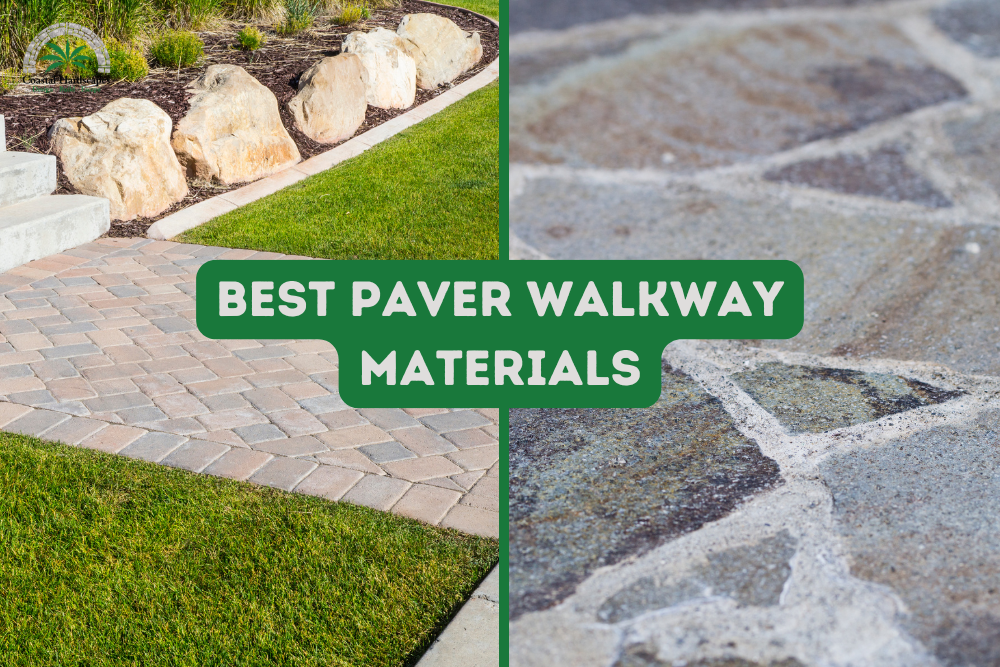
Walkway options, such as bluestone and traditional masonry pavers, can vary in price. You should consider factors such as pressure washing needs and renovation budgets, ensuring each choice fits your space.
Here are the average costs per square foot:
| Material | Cost Range | Maintenance |
|---|---|---|
| Bluestone | $15 – $30/sq ft | Low upkeep, and pressure washing is recommended |
| Masonry Pavers | $10 – $25/sq ft | Ideal for renovation projects and landscaped spaces (pavers) |
| Concrete | $5 – $15/sq ft | Cost-effective, simple maintenance |
Walkway Material & Aesthetic Appeal
The best walkway material will usually depend on what style and look you are after. Some homeowners in Savannah prefer a natural look, while others want a modern paver patio. We recommend evaluating each walkway option for its visual charm and style versatility, ensuring the design enhances both curb appeal and accessibility.
For commercial spaces, including options that allow wheelchair users and pedestrians to navigate effortlessly, often means the natural stone is out of the picture. In our experience, we recommend materials that blend beauty with functionality, providing an attractive and practical solution.
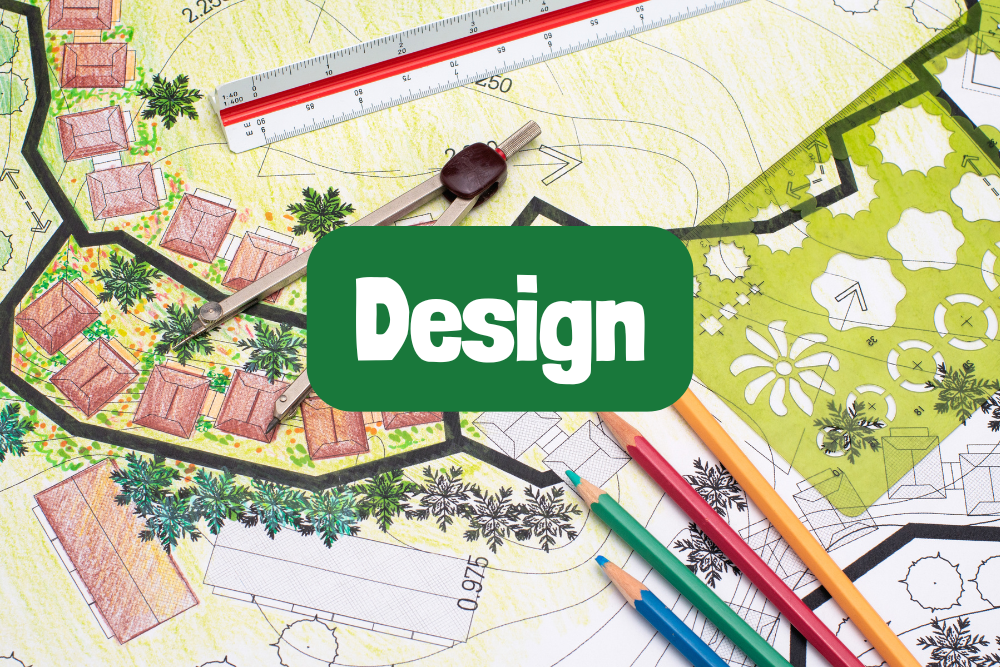
Need help designing your outdoor living area?
See how our team can help you design the PERFECT backyard space for your home!
5 Popular Walkway Materials for Your Yard
I review popular walkway materials to help you make informed choices. I outline the benefits of gravel, brick pathways, and concrete pavers, note the durability of flagstone, and highlight wooden walkways’ unique aesthetics. Our guide provides hardscaping insights, discusses cost implications, suggests the right tool for the job, and considers climate effects—all from a handyman’s perspective.
1. Gravel for Walkways (Budget-friendly)
We have found gravel walkways the most cost-friendly investment for any yard. It provides a textured base that pairs well with a mosaic of design elements, such as cobblestone accents and strategic lighting. Working with a reliable landscaping company has shown me that gravel paths are low-cost and durable, perfect for creating a natural appeal while minimizing recurrent maintenance efforts when installed correctly.
- Pros = cost, durability, ease of installation.
- Cons = maintenance with weeds, uneven surfaces, and steel edging during installation.
2. Brick Pathways (Classic look)
Brick pathways offer a lasting finish that improves any yard and walkway. Brick also enhances patio areas, ensuring your home improvement investment lasts over time. Since these brick designs require minimal maintenance, we help clients save money on upkeep, providing an innovative and practical solution for busy homeowners.
- Pros = durability, low maintenance.
- Cons = upfront costs, can crack over time if not utilized correctly
3. Concrete Pavers (Durable & Customizable)
Here at Coastal Hardscapes, we utilize concrete pavers to upgrade most outdoor spaces, as they offer excellent durability and affordability. Pavers can complement any style of home since there are so many customizable colors and patterns that not only ensure long-term performance but also visual appeal:
- Durability that stands up to wear and tear
- Enhanced aesthetics to match various wall and home designs
- Improved outdoor space functionality
- Resistance to mold with proper maintenance
- Easy maintenance for a reliable, attractive finish
- More affordable than brick
As we mentioned earlier, one type of paver that is great for walkways is the permeable paver, which can be used in high-traffic areas and areas with erosion issues. These pavers complement your stormwater management by helping to redirect water back to the ground.
4. Flagstone Walkways (Natural Appeal)
Some homeowners love the natural look of a flagstone walkway. We personally appreciate the natural color variations and subtle patterns that complement the landscape around a tree or even a well-placed patio. We often recommend proper waterproofing treatments (especially in Savannah) to ensure longevity and maintain the aesthetic appeal of natural walkways. This choice meets functional needs and provides a lasting design solution that enhances your property’s overall charm.
- Pros = cost, durability, ease of installation.
- Cons = maintenance with weeds, uneven surface.
5. Wooden Walkways
Though not as often, we have installed wooden walkways using everything from new lumber to reclaimed pallet wood, which pair well with natural touches such as pebble accents and limestone borders. By doing this, you can create a design that stands out with its durability and charm but also affordability. We recommend trying a wood walkway when you have low-lying land with standing water and need a solution to elevate your walkways without tons of excavation, which is expensive.
- Pros = cost, elevated style, nostalgic feel fits Savannah
- Cons = maintenance with wood and upkeep (staining, replacing boards).
6. Natural Walkways
| Element | Feature |
|---|---|
| Pebble | Provides a textured detail that enhances visual interest |
| Limestone | Adds a refined border that compliments the wooded design |
| Pallet | Offers a sustainable option with robust durability |
| Walkway | Delivers a customized path that blends aesthetic and function |
More Paver Articles ⬇️
Designing Your Perfect Walkway in 4 Steps
We plan layouts for optimal flow and access while incorporating lighting and combining materials for a unique look. We add smooth transitions between spaces and select complementary landscaping features. Our approach applies to front yard projects with decomposed granite and gravel accents and designs for the swimming pool and sheds, ensuring practical and appealing solutions.
1. Walkways for Optimal Flow and Access
We design walkway layouts to emphasize optimal flow and easy access for homeowners. I integrate practical aspects like efficient plumbing designs and durable concrete surfaces that hold up in ice conditions. I ensure the pathways incorporate environmentally friendly features and natural materials, providing a safe and attractive route and supporting sustainable solutions for everyday use.
2. Incorporating Lighting Into Your Walkway Design
Adding well-placed lighting to your walkway significantly improves safety and the overall ambiance, especially near your fireplace and flagstone paths. Strategic lighting guides guests along well-lit routes and supports hassle-free landscaping by highlighting features and assisting with weed control tasks. It makes maintenance more straightforward, even for a project as small as a pea-sized detail. This approach enhances your yard’s visual appeal and functionality, ensuring every step is secure and stylish.
3. Creating a Transition Between Spaces With Design
With our design team, we can design transitions between spaces by integrating innovative drainage systems that efficiently manage water flow, ensuring your landscape remains free from unnecessary buildup and pest control issues. I have seen firsthand how a well-planned walkway can boost the overall beauty of your yard while creating clear, functional zones that make maintenance and daily use more straightforward.
4. Selecting Complementary Landscaping Features
I strategically choose landscaping elements that complement your walkway design, focusing on natural features that add structure while keeping maintenance simple. We often integrate fragrant thyme along the border, ensure the adjacent surfaces are mulched, and use carefully selected soil and a distinct shape to emphasize a clean, inviting yard design.
Addressing Common Concerns When Choosing Walkway Materials
When installing new walkways, always consider weather effects and climate. The Savannah region usually does best with concrete surfaces over wood. Wood ages fast in the hot and humid climate, and we don’t have to deal with freezing temperatures either.
| Material | Weather Impact | Longevity | Maintenance |
|---|---|---|---|
| Concrete | Resistant to freeze-thaw cycles | High | Low |
| Rock | Endures erosion with proper placement | Very High | Moderate |
| Wood | Susceptible to moisture damage | Moderate | High |
Handling Soil and Drainage Issues
Before building a new walkway, we continually assess the soil and drainage concerns in the yard. We have found that proper grading and strategic placement of pavers guarantee adequate water runoff, helping prevent pooling or soil erosion, which leads to a safer and more lasting design:
- Check the level and slope of the yard dimension
- Plan the length of the pathway to align with drainage points
- Integrate concrete pavers to enhance stability
- Maintain nearby grass by ensuring proper runoff
Adapting Designs for Sloped Yards
While the Savannah area doesn’t have many sloped yards, sometimes we have to build walkways and account for slopes. Using a combination of sand for leveling and a paver walkway for stability ensures that each step integrates seamlessly with the terrain’s natural contours. I incorporate lumber and crushed stone to create a unified look that bridges design functionality with a natural appearance, allowing safe access while effectively managing water runoff.
Maintenance Tips for Long-Lasting Walkways
Seasonal upkeep, like power washing and surfactants, is vital for maintaining concrete, concrete pavers, and wood surfaces (not natural stone). Also, quick repair of foot trail damage and enhancing longevity with proper installation techniques, like a solid paver base and quality landscape fabric. I also compare DIY approaches with professional installation, linking these tips to clever garden design for a well-maintained outdoor path.
Repairing Common Damage Quickly
We recommend that you immediately repair any visible damage by replacing cracked pavers and reinforcing loose edges near the porch to prevent further issues and ensure that the repair work stands up against daily wear. I also inspect the irrigation system to curb excessive moisture buildup that could lead to more damage, ensuring that practical and timely fixes keep your walkway safe and lasting.
Enhancing Longevity With Proper Installation
I have learned that a robust installation method can considerably extend your walkway’s life by ensuring each component is secured on a compacted base, which helps prevent shifting and wear. I have overcome common issues such as uneven surfaces and early deterioration by using quality materials and adhering to precise layout measurements. I recommend a careful setup process that includes proper drainage and edge restraints for a more stable pathway. Investing time and care during installation delivers a maintenance-friendly result that lasts, making your yard both functional and attractive over time.
DIY vs. Professional Installation
I have found that tackling your walkway installation alone can offer a sense of satisfaction and cost savings. Yet, professional installation often ensures a durable, well-planned foundation that reduces future maintenance worries.
Professional hardscaping expertise guarantees precise measurements, proper drainage, and a secure base, which ultimately extends the lifespan of your pathway and minimizes repair needs. My experience tells me that blending both approaches—handling simple tasks yourself while relying on experts for critical aspects—can strike the perfect balance between quality and budget.
Hire Local Landscaping Experts for Ideas
Now you know which is the best walkway for your yard… we hope!
When you design and install a walkway, it is not usually a cheap investment. In most cases, your walkway will cost several thousand dollars, so working with local landscaping experts with a solid reputation is essential.
A professional hardscaping company like Coastal Hardscapes can provide expert advice on materials and layouts that create inviting and practical yard spaces. Our hands-on experience and practical examples offer valuable ideas that address common challenges and maximize functionality and beauty in outdoor living areas.
To book a walkway consultation, reach out below:
Frequently Asked Questions
1. What walkway materials best suit my home’s style?
The best walkway materials vary depending on functionality and style. However, we recommend concrete pavers for most homeowners because they can match any home style, from contemporary to modern. Concrete pavers offer durability and customization; unlike concrete, they require little maintenance.
2. How do various walkway materials compare in durability for Savannah?
Depending on who you ask, some hardscape experts say concrete typically stands strong for years, while pavers or stone may need more upkeep. However, in our experience, most homeowners prefer pavers over concrete for the curb appeal, versatility, and ability to repair (concrete is challenging to repair and more expensive to maintain).
3. Which walkway design best meshes with my outdoor decor?
We always recommend a hardscape design that complements your outdoor decor, is visually appealing, and matches the exterior colors of your home. You usually want the colors to blend with your siding and landscaping. Regarding styles, the best design matches your landscaping, and you will need to choose between straight lines or curved walkways.
4. What are common concerns when choosing walkway materials?
Homeowners often worry about durability, safety, and cost when selecting walkway materials. I focus on slip resistance, maintenance needs, and design harmony to deliver hardscape solutions that perform well on the property.
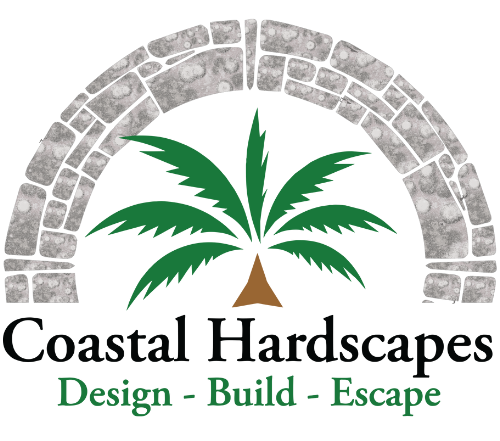
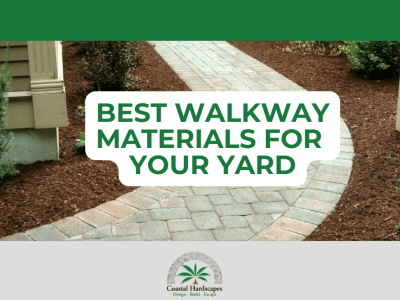


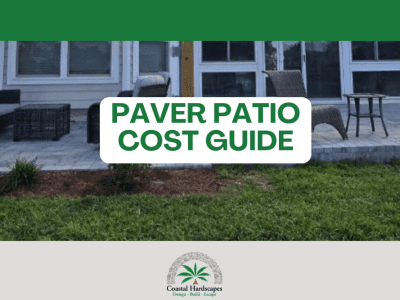
 Patio and Screened in Porch Costs – Complete Guide
Patio and Screened in Porch Costs – Complete Guide